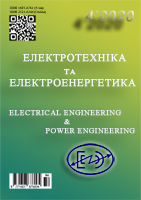Analysis of electric drive systems for performance of driving and starting under load
DOI:
https://doi.org/10.15588/1607-6761-2020-4-2Keywords:
autotransformer start, amplitude - phase control, vector-pulse control, quasi-frequency mode, thyristor regulatorAbstract
Purpose. Perform an analysis of existing automated control systems of the electric drive and methods of forming the starting torque to determine the compliance of the selected system and method to the requirements for trouble-free mode of start and start of the technological mechanism in difficult conditions or breakaway and start under load..
Methodology. Comparison of energy performance and capabilities of control systems and methods for the formation of starting torque, mathematical calculations, analysis of the properties of systems and methods in accordance with the requirements of technological operations during the start.
Findings. To obtain the results of the analysis of the current methods of starting induction motors, autotransformer start was considered, which can significantly reduce the starting current, and also connect a capacitor with a reactance to reduce the current and increase the starting torque; the use of soft start with amplitude-phase control allows you to reduce the starting current and reached the absence of its impulses. The vector-pulse method of controlling the converting device increases the starting torque in the absence of an increase in starting current, such advantages have a quasi-frequency starting mode, but the application is limited by special technological equipment. Thyristor voltage regulator using the phase control method, despite its widespread use in control systems, has a low value of the starting torque. To carry out starting in difficult conditions, according to the results of the analysis of existing systems of controlled starting, it was found that a rational electric drive system for hoisting-and-transport mechanisms is a frequency-controlled electric drive system according to the "frequency converter - asynchronous motor" (FC - IM) scheme.
Originality. For the first time it is proposed to improve the existing control systems of hoisting and transport mechanisms that perform start-up in difficult conditions when using the modes of movement to form the starting torque that exceeds the passport value by 3-4 times. Increasing energy efficiency based on increasing their efficiency, information content and data reliability. For the first time, the reasons for the shortcomings of existing control systems during start-up under load in modern production are analyzed.
Practical value. The choice of a rational electric drive system for lifting and transport mechanisms is substantiated when starting in difficult conditions, which will provide maximum efforts in the transmission of a technological mechanism with permissible current and thermal overloads of asynchronous machines.
References
Sandler A.S., Sarbatov R.S. (1974) Automatic fre-quency control of induction motors. M.: Energy. 328.
Klepikov V.B. (2014) Dynamics of electromechanical systems with nonlinear friction: a monograph. H.: Publishing house "Textbooks of NTU" KhPI ". 408 p.
Benglsu n. t., AKay A. stability of friction-induced vi-brations in roulty-degree-of-freedom systems. Jorn. of Sound and Vi.br. 1994. Ho 4, R. 557–570.
Balik J., Lukac P. On the kinetics of dynamic strain aging // Kovove Mater. 1998. V. 36. No. 1. P. 3–9.
Eliseeva E.A., Shinyansky A.V. (1983) Handbook of automated electric drive. M.: Higher school. 616.
Katsman M.M. (2013) Electric machines: [textbook for students. institutions environments. prof. educa-tion (12th ed., erased)]. M.: Publishing Center "Acad-emy". 496.
Petrov I.I., Meistel A.M. (1968) Special modes of op-eration of asynchronous electric drive. M.: Energiya. 264.
Voitekh A.A., Popovich A.N., Bibik E.V. (2002) Math-ematical model of optimal design of an induction motor with pre-connected capacitors for heavy start-up conditions Visnyk of Kremenchug State Polytech-nic University. 1. 361–363.
Popovich N.G., Pechnik N.V. (2000) Electromechani-cal automation systems and the problem of energy saving Bulletin of the KhDPU. Collection of scien-tific works.113. 297–300.
Petrov L.P. (1981) Control of starting and braking of induction motors. M.: Energoizdat. 184.
Gerasimyak R.P., Leshchev V.A., Putilin N.S. (1984) Asynchronous electric drive with thyristor control. К.: Machinery. 150.
Braslavsky A. Ya. (1988) Asynchronous semicon-ductor electric drive with parametric control. M.: En-ergoatomizdat. 224.
Krecek, T., Brandstetter, P., Korbel, P. Nonmodel Based Sensorless Vector Control of Permanent Mag-net Synchronous Motor. In ISIE, Cambridge, 2008,
p. 618–623
Petrushin B. C., Yakimets A. M., Grusha A.V., Ka-lenik O.V. (2008) Energeticheskie i teplovye poka-zateli reguliruemykh asynchronnykh dvigateliv u taking into account higher spatial-temporal harmon-ics Elektromashinostroyuvanie ta elektrooblad-nannya: Mizhvid. scientific and technical zb. 70. 68 - 71.
Simulation of induction motor startup. MotorA-nalysis Example1. N.p., n.d. Web. 29 June 2017.
Baskov S.N., Usaty D. Yu., Radionov A.A. (2004) Start of asynchronous motor in electric drives with increased starting torque Izvestiya vysshikh uchebnykh zavedenii. Electromechanics. 2. 47–49.
The principle of operation of soft-start devices. Ac-cess mode: URL: http://www.softstarter.ru/ plavnij-pusk / upp / princip_dejstviya /
Cherny A.P., Gladyr A.I., Osadchuk Yu.G. et al. (2006) Starting systems of unregulated electric drives [Text] Kremenchug: PE Shcherbatykh AV: 280.
Downloads
Published
How to Cite
Issue
Section
License

This work is licensed under a Creative Commons Attribution 4.0 International License.
Creative Commons Licensing Notifications in the Copyright Notices
Authors who publish with this journal agree to the following terms:
Authors retain copyright and grant the journal right of first publication with the work simultaneously licensed under aCreative Commons Attribution License that allows others to share the work with an acknowledgement of the work's authorship and initial publication in this journal.
Authors are able to enter into separate, additional contractual arrangements for the non-exclusive distribution of the journal's published version of the work (e.g., post it to an institutional repository or publish it in a book), with an acknowledgement of its initial publication in this journal.
Authors are permitted and encouraged to post their work online (e.g., in institutional repositories or on their website) prior to and during the submission process, as it can lead to productive exchanges, as well as earlier and greater citation of published work.

